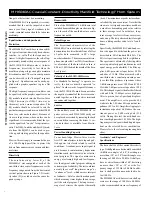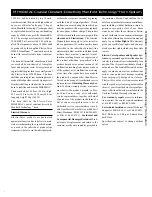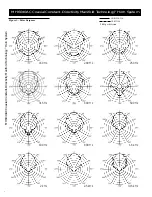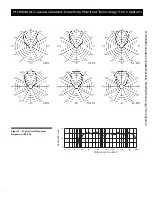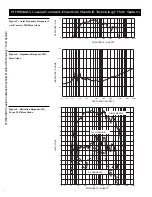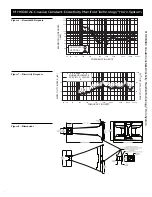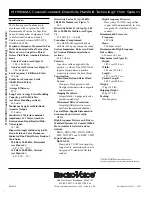
MH6040AC Coaxial Constant-Directivity Manifold Technology
Horn System
2
MH6040AC Coaxial Constant-Directivity Manifold T
echnolog
y
Horn System
flange to aid electrical box mounting.
If the MH6040AC is suspended, it is recom-
mended that the unit be inspected at least
once a year. If any sign of weakness is de-
tected, remedial action should be taken im-
mediately.
Equalization and Subpassband
Protection
The MH6040AC’s mid-bass section exhib-
its typical constant-directivity horn charac-
teristics, i.e., roll-off at the frequency ex-
tremes. At higher frequencies, the roll-off ap-
proximately matches the power-response of
the DL10X-SH (6 dB per octave). At lower
frequencies, directivity is lost when the
mouth is no longer large enough to maintain
directional control. These two consequences
can be observed in the “humped” response
in Figure 3. Equalization can be easily ap-
plied with a graphic equalizer to give a flat
response.
The high-frequency compression driver can
be equalized with a graphic equalizer or an
EQ module inserted into the Electro-Voice
XEQ-2 (two-way) or XEQ-3 (two-way or
three-way) active crossover/equalizer. The
EQ module should be selected to suit the
particular compression driver and the HP640
horn (see relevant data sheet). Because of
its use in large arenas, where air loss can be
significant, it is recommended that the sys-
tem be equalized “on site” for optimum re-
sults. The XEQ-3 and the mid-bass EQ mod-
ule from the EQMT-2 can be used to pro-
vide a good starting point for the equaliza-
tion.
Electro-Voice strongly recommends the use
of a 100-Hz high-pass filter to protect the
drivers from unnecessary excursion and ther-
mal stress.
Directivity
The axial directivity factor R
q
of the
MH6040AC was computed at each of the
one-third-octave center frequencies over the
frequency range noted from the horizontal/
vertical polars shown in Figure 7. Directiv-
ity index (D
i
) was taken over the same fre-
quency range.
Beamwidth
Plots of the MH6040AC’s 6-dB-down total
included beamwidth angles are shown in Fig-
ure 6 for each of the one-third-octave center
frequencies noted.
Polar Response
The directional characteristics of the
MH6040AC were obtained by selecting the
horizontal and vertical details from a full set
of polar data measured in EV’s large
anechoic chamber. The measurement micro-
phone was placed 6.1 m (20 ft) from the cen-
ter of rotation of the horn which, in turn, is
0.94 m (3.08 ft) behind the mouth of the horn.
See Figure 1.
Polarity of the DL10X-SH Drivers
For Manifold Technology
®
to operate cor-
rectly, the drivers must be operated “in
phase.” In other words, for parallel connec-
tion, the DL10X-SH’s must be connected so
the negative terminals of the drivers are con-
nected together, and the positive terminals
are connected together.
Service
In the unlikely event the MH6040AC re-
quires service, each DL10X-SH easily can
be replaced or serviced by removing the back
cover and then removing the driver. A ser-
vice data sheet is available from Electro-
Voice.
Power Handling Capacity
To our knowledge, Electro-Voice was the
first U.S. manufacturer to develop and pub-
lish a power test closely related to real-life
conditions. A random-noise input signal is
used because it contains many frequencies
simultaneously, just like real voice or instru-
ment program. The signal contains more
energy at extremely high and low frequen-
cies than typical actual program, adding an
extra margin of reliability. The test combines
not only the overall “long-term average” or
“continuous” level—which our ears interpret
as loudness—but also short-duration peaks
which are many times higher than average,
just like actual program. The long-term av-
erage level stresses the speaker thermally
(heat). The instantaneous peaks test mechani-
cal reliability (cone excursion). Note that the
sine-wave test signals sometimes used have
a much less demanding peak value relative
to their average level. In actual use, long-
term average levels exist from several sec-
onds on up. The test performed lasts for eight
hours, adding another extra level of confi-
dence.
Specifically, the MH6040AC mid-band sec-
tion is designed to withstand the power test
described in EIA Standard RS-426A. The
EIA test spectrum is applied for eight hours.
The spectrum is obtained by filtering white
noise (a particular type of random noise with
equal energy per bandwidth). The filter ap-
plies 6-dB-per-octave slopes below 40 Hz
and above 318 Hz. When measured with a
one-third-octave constant-percentage ana-
lyzer, this filter produces a spectrum whose
3-dB-down points are at 100 Hz and 1,200
Hz with a 3-dB-per-octave slope above 1,200
Hz. This shaped signal is then further filtered
with an 80-Hz, 12-dB-per-octave high-pass
filter to prevent out-of-passband displace-
ment. The amplifier is set to provide 600
watts into the 3.45-ohm EIA equivalent im-
pedance (45.5 volts). Amplifier clipping sets
instantaneous peaks at 6 dB above the con-
tinuous power or 2,400 watts peak (91.0
volts). During this test, the mid-band sec-
tion is not high passed at 1,250 Hz. The high-
frequency section’s power handling is depen-
dent on the selected driver combination.
Please refer to the relevant engineering data
sheet.
Architects’ and Engineers’
Specifications
The horn shall be of the constant-directivity
type. It shall produce a horizontal beamwidth
(6-dB-down angle) of -60°, deviating no
more than +10° or –20° from this angle over
the range of 400 Hz to 20 kHz. It shall pro-
duce a vertical beamwidth of 40°, deviating
no more than +20° or –15° over the fre-
quency range of 325 Hz to 20 kHz. In addi-
tion, it shall provide an acoustic load to be-
low 100 Hz.
The MH6040AC mid-bass section shall op-
erate over the range of 100 Hz to 4,000 Hz,
with a recommended crossover frequency of


